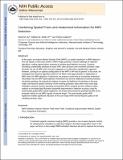Combining spatial priors and anatomical information for fMRI detection
Author(s)
Ou, Wanmei; Wells, William M.; Golland, Polina
DownloadGolland_Combining spatial.pdf (3.656Mb)
PUBLISHER_CC
Publisher with Creative Commons License
Creative Commons Attribution
Terms of use
Metadata
Show full item recordAbstract
In this paper, we analyze Markov Random Field (MRF) as a spatial regularizer in fMRI detection. The low signal-to-noise ratio (SNR) in fMRI images presents a serious challenge for detection algorithms, making regularization necessary to achieve good detection accuracy. Gaussian smoothing, traditionally employed to boost SNR, often produces over-smoothed activation maps. Recently, the use of MRF priors has been suggested as an alternative regularization approach. However, solving for an optimal configuration of the MRF is NP-hard in general. In this work, we investigate fast inference algorithms based on the Mean Field approximation in application to MRF priors for fMRI detection. Furthermore, we propose a novel way to incorporate anatomical information into the MRF-based detection framework and into the traditional smoothing methods. Intuitively speaking, the anatomical evidence increases the likelihood of activation in the gray matter and improves spatial coherency of the resulting activation maps within each tissue type. Validation using the receiver operating characteristic (ROC) analysis and the confusion matrix analysis on simulated data illustrates substantial improvement in detection accuracy using the anatomically guided MRF spatial regularizer. We further demonstrate the potential benefits of the proposed method in real fMRI signals of reduced length. The anatomically guided MRF regularizer enables significant reduction of the scan length while maintaining the quality of the resulting activation maps.
Date issued
2010-03Department
Massachusetts Institute of Technology. Computer Science and Artificial Intelligence Laboratory; Massachusetts Institute of Technology. Department of Electrical Engineering and Computer ScienceJournal
Medical Image Analysis
Publisher
Elsevier
Citation
Ou, Wanmei, William M. Wells, and Polina Golland. “Combining Spatial Priors and Anatomical Information for fMRI Detection.” Medical Image Analysis 14, no. 3 (June 2010): 318–331.
Version: Author's final manuscript
ISSN
13618415